Spotlight Story
On the menu, downsized dining out
September 12, 2013
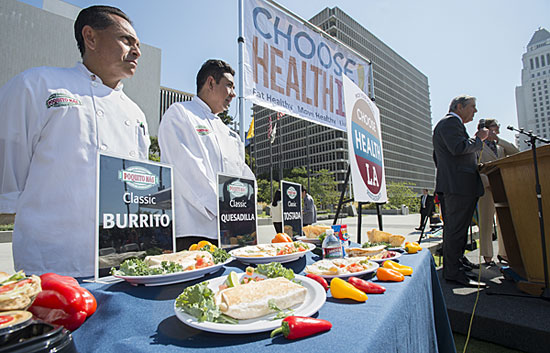
Full-sized restaurant fare along with smaller portion alternatives were on display at news conference.
At Poquito Más eateries, they like to boast that they “always give you a little more than anyone else.”
These days, a little more can also mean a little less.
And, according to founder and owner Kevin McCarney, customers are eating it up.
The chain started offering trademark “petito” servings of its seven most popular dishes about eight years ago. “The epiphany was that people come in different sizes; portions should, too,” McCarney said. “I’m 180 pounds, my wife’s 105. We couldn’t possibly finish the same portion.” Business boomed as less-stuffed patrons came around to dine more frequently at Poquito Más’ 11 outlets.
Today, McCarney, who started his first restaurant in Studio City almost 29 years ago, finds himself on the cutting edge of the latest trend in public health.
Poquito Más—along with Subway, Lido di Manhattan Ristorante, Deano’s Gourmet Pizza, Localita and other restaurants around Los Angeles offering slimmed-down portion options—is part of a first-ever “healthy restaurants partnership” with the county Department of Public Health.
It’s the latest push in the county’s high-profile fight against obesity that has included consciousness-raising on calorie counts, an assault on unhealthy food in preschools, and a showdown over sugar in soft drinks.
With nearly two-thirds of county residents overweight or obese, the educational campaign has significant public health consequences.
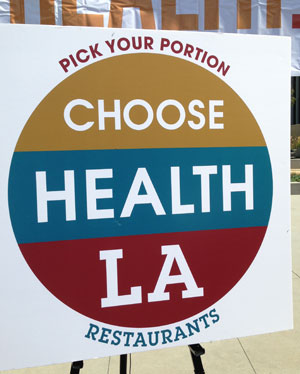
Public health officials urge you to look for this window decal. An enlarged version was on display at news conference Thursday.
“This is a terrible epidemic,” Dr. Jonathan E. Fielding, the county’s director of public health, said in announcing the new portion-size program at a news conference Thursday. While he emphasized there is no panacea to solving the problem of obesity and its related diseases, he said initiatives like this can make a big difference. “This is very important because when people go out to eat, they generally consume more calories than they do when they eat at home, and people are eating out more and more.”
Restaurants in the program will display a Choose Health L.A. window decal that includes the slogan “Pick your portion.”
“It’s a matter of pride to have this decal,” Fielding said, adding that he has assigned a dedicated staff member to assist restaurants in joining up. To qualify, restaurants must offer smaller portion options in addition to their regular fare; serve children’s meals that include fruits, vegatables, non-fried items and healthy drinks; and provide chilled water as a free beverage offering. (Details of how restaurants can apply are here.)
Supervisor Zev Yaroslavsky, a longtime supporter of programs that foster healthier eating choices, said the new effort will be effective because it will allow consumers to continue to chow down on tasty restaurant fare—even as they downsize the serving sizes.
“It’s not mandatory,” Yaroslavsky said. “We’re not forcing people not to drink heavily sugared drinks. …but we’re giving people an alternative…When the sandwich looks just as good at 700 calories as it does at 1,600 calories, people will opt for the lesser caloric intake.”
“The average family today goes out to eat in a restaurant four times a week,” he continued. “If we can offer a healthy alternative at the restaurants… we can make a huge impact on this issue of obesity, improve the quality of life for men, women and especially children, and save the taxpayers billions of dollars a year nationally, and tens of millions, if not more, locally.”
A key goal is helping parents make better food choices on behalf of their children, said Kim Belshé, executive director of the childrens’ advocacy organization First 5 L.A., which is also supporting the initiative.
“It is a disturbingly shocking statistic that nearly a quarter of low-income children three- and four-years-old in L.A. County are obese or overweight,” Belshé said.
Prices for the reduced portions will be up to the individual restaurateurs. McCarney, of Poquito Más, says his “petitos” are 60% of the size of the regular servings and cost 60% as much.
McCarney, who first fell in love with Mexican food after sampling a carnitas taco at an Echo Park car wash when he was 17, said all of his customers can benefit from the smaller menu options he offers in his restaurants—not just those who are watching their weight. There are days when they may want one of the “more opulent choices” available, like a full-sized scampi or ahi burrito, but other times when a scaled-down version will do.
In his view, it’s high time to forget the old adage about eating everything on our plates, anyway.
“I think that’s a mistake in today’s world,” he said.
Because of Poquito Más’ reputation as a health-savvy local restaurant chain, public health officials sought out McCarney when it was time to roll out the new portion size campaign.
Even as the word spreads, however, he says he’s not worried about competitors taking a page from his “petitos” playbook.
“It took me too long to jump on this,” McCarney said. “I’m just glad that other people are seeing the light.”
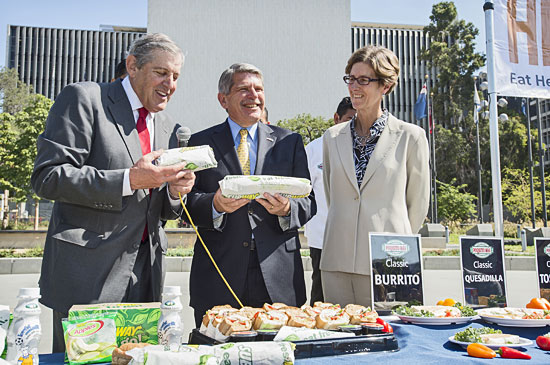
What's for lunch? Mulling choices are, from left, Dr. Jonathan E. Fielding, Supervisor Zev Yaroslavsky, Kim Belshé.
Posted 9/12/13
Where summer lingers after Labor Day
August 29, 2013

Lance Wichmann says he finds serenity on the Santa Monica sand when the crowds disappear in September.
Lance Wichmann’s playpen was a patch of warm sand at the foot of Ocean Park Boulevard. His family’s Santa Monica house was less than a block from the beach, and his mom started carrying him there before he could walk.
Today, more than seven decades later, you can still find Wichmann at that same spot, sunning himself in retirement, a few tentative steps from the shoreline home that remains in the family. He knows just about everything there is to know about beach life around lifeguard station 26, which draws some of the heaviest crowds in Southern California during June, July and August.
And one of the things Wichmann knows (besides the best body-surfing breaks) is this: although Labor Day on Monday represents the unofficial end of summer, it’s the beginning of a two-month-long, locals-only holiday, when ideal conditions come to the beach—but not the people. The truth is that, unlike other coastal areas throughout the nation, air and sea temperatures here drop an average of only a few degrees between Labor Day and Halloween.
“It’s so much quieter,” the 72-year-old former insurance executive said of LA.’s extended summer season of September and October. “I know Santa Monica is a tourist town, but I like it when I can come down here at low tide, when the kids are back in school, and walk along the sand by myself. To me, it’s spiritual.”
Let the rest of the country use Labor Day as its farewell to summer. Here in L.A., savvy beachgoers know that the occasion actually signals “the start of the beach season,” joked county lifeguard Captain Kyle Daniels, who oversees community services and youth programs. In September and October, he says, “the days are warmer, the winds are lighter and the views of Catalina are better.”
And the crowds are so much thinner that, after Labor Day, lifeguard stations are staffed every mile or more, rather than every 200 yards. “I don’t want to say it’s easy,” Daniels said of the workload that comes with reduced staffing levels. “But it’s less intense.”
There are other signs in the bureaucracy that, come this weekend, vacationers are about to vanish.
Carol Baker, a spokesperson for the Department of Beaches and Harbors, offered this post-Labor Day tidbit: the agency’s facilities and property maintenance division, which oversees beach restrooms, has just received its last major order of toilet paper and expects to use only 400 cases during the winter months, compared to as many as 1,000 cases during the summer.
When asked about her own favorite beach month, Baker declined to pick a favorite. “I know this will sound like a bubbly cheerleader, but every month at the beach is my favorite.” That said, she acknowledged that “some of the best summer days are in the fall.”
And that may be particularly true this year because of the fog that has shrouded the coastline during August—or, as Baker calls it, “Fogust.” This week saw some of the best weather of the summer, with the weekday visitor count already way down.
“In July, you could barely see the sand, there were so many people,” lifeguard Chris Smith said on a brilliant Tuesday afternoon as he kept watch over a couple of body boarders and surfers not far from where Wichmann was working on his tan. “The crowd is non-existent right now.”
“It’s a secret,” he added, “that the beach season is still going strong in October.”
Up along the bike path, meanwhile, business was slow enough at Perry’s café that chef Robin Hathaway could take a break to talk to a visitor about the post-Labor Day rhythms. “All the locals come down to reclaim their spots,” Hathaway said. “People have their routines. It’s more health and fitness oriented—running, riding, yoga, skate boarding, surfing.”
Of course, if the café had its way, she said with a wink, “summer would last forever.”
Posted 8/29/13
Where CBS blackout hits home
August 14, 2013
In the weeks since Time Warner Cable and CBS began feuding, Leadora Sutton has been having technical difficulties in her daily life.
“My main show is ’60 Minutes’ and I miss it terribly,” complains Sutton, 84, whose Westside senior apartment house—like much of Los Angeles—is served by Time Warner. “And I can’t get ‘Family Feud’, which I like to watch at 6 o’clock as I eat dinner. It’s a silly show, but I relax with it. And now it’s gone because we can’t get Channel 9.”
Sutton isn’t the only cable customer who wishes her regularly scheduled programming would resume already. As the ongoing contract dispute between the two media behemoths entered its third week and federal officials fired off letters urging the companies to settle their differences, some 3 million customers this week remained caught in the middle of the argument over their distribution deal.
Lots of folks are annoyed, but nowhere is the aggravation more pronounced than among seniors, who’ve long been the network’s most loyal fans. Their screen-happy kids and grandkids may not miss it so much, what with their binge-watching back episodes of “Breaking Bad” on Netflix, or getting their comedy fix via YouTube on their phones. But for this crowd, losing CBS—with the most mature audience of the four major networks and an average viewer age of almost 57—is like losing an old friend.
“TV is an amazing issue with seniors,” says Doug Cope, director of operations for the Menorah Housing Foundation, which oversees 18 low-income apartment buildings for seniors throughout Los Angeles County, including Sutton’s. “If people start missing their programs,” he says, “you hear from them.”
Since August 2, Time Warner has been blocking out CBS in a standoff over how much the cable giant will pay the network to carry CBS-owned stations in Los Angeles, New York and Dallas. For subscribers here, that has meant not only the absence of popular shows such as “60 Minutes”, “NCIS” and “The Big Bang Theory,” but also the blackout of CBS-owned stations such as Showtime and KCAL Channel 9, which—crucially, in this winning season—airs the Los Angeles Dodgers.
“It’s not a life-or-death thing for the people I’ve heard from,” jokes Robert Miret, manager of the Zev Yaroslavsky Apartments where Sutton lives near Westwood. But, he notes, he is part of another contingent that is increasingly resenting the blackout—sports fans. “So for me . . . “
Miret was among thousands this month who missed the Dodgers game against the St. Louis Cardinals because KCAL was dark on his home television. The blackout continued this week as the Dodgers played the New York Mets—again, only for non-Time Warner viewers. And, Miret notes, football season is about to begin.
For his tenants, however, the irritation has more to do with the interruption of daily habits. Though the complex also offers satellite dish and basic antenna hookups, many of the tenants have chosen the option they’re most used to, which is cable. And, he notes, many can’t switch because the basic antenna hookup is only for high-definition TV, and most of the tenants own older models.
So they’re stuck, he says, and even those who own computers don’t see television the way their grandchildren see it, as just one screen among many. For their generation, and even for many of their children, TV is also a marker of time and a companion. And retirees tend to watch a lot of it.
“Sometimes I’m not out of the house until three or four in the afternoon, now that I’m not working, and as I’m making lunch, I like to watch the shows,” says 67-year-old Sandy Tenenbaum. “I watch ‘The Talk’, which is very interesting. I watch ‘The Doctors’, which is a very informative and educational. I watch ‘Dr. Phil.’ At seven o’clock I watch that ‘Insider’ gossip show with the celebrities.”
Sutton, whose TV now displays Time Warner’s negotiating position when she turns to her favorite channel, says she is making do with other shows while her cable company and her favorite network do battle.
“They’ll fight it out and it’ll be settled in a few weeks,” she predicts. (Meanwhile, CBS has stayed on top of its rivals in the ratings, blackout notwithstanding.)
But without her shows to divert her, Sutton says, she made a call the other day to Time Warner, and came away with an interesting tidbit—confirmed this week by sales representatives at the company’s online support center.
“Did you know,” she asks, “that I can get discounts on my utility bills, my phone bills, even my movie tickets, but my cable company doesn’t give a break to senior citizens?”
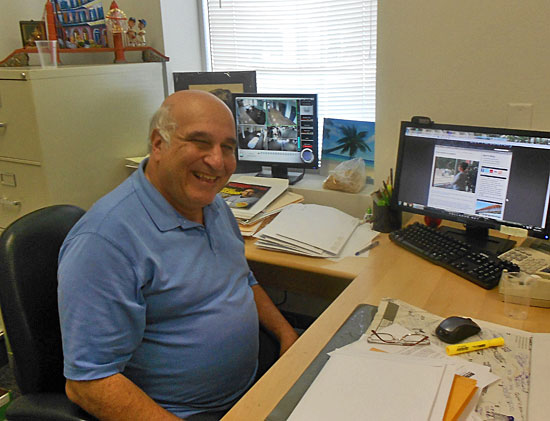
Bob Miret’s fingers are crossed that the blackout will be over in time for football season, in a few weeks.
Posted 8/14/13
New law serves up a cottage industry
July 18, 2013
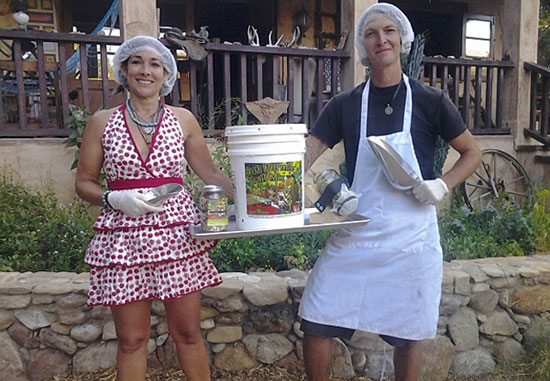
Lisa Cianci and Ben Lawson of Ant Permie's are among hundreds taking advantage of the Homemade Food Act.
Gene Holmon’s spice mix was so good that his Woodland Hills family urged him to sell it. Jessica Schnyder learned to make jam and pickles from her Hollywood chef friend, Amanda Carr.
Kyle and Liz von Hasseln, grads of Southern California Institute of Architecture, were playing with a three-dimensional printer one day when they realized they could make sugar sculptures. Shantal Derboghosian, a Van Nuys engineer, was unemployed when she discovered a gift for baking. Ben Lawson perfected his organic, sustainable trail mix in Topanga when he wasn’t drumming for a Long Beach punk/grind-crust band.
Until about six months ago, few, if any, of them could have profited much from their passions. But today, they and hundreds of others are part of an entrepreneurial boomlet ignited by a new state law allowing Californians to make food for sale from their home kitchens.
The California Homemade Food Act, which created a new category of food production called “cottage food operation,” has been in effect since January and, according to health officials, few places have seized on it with the excitement of Los Angeles County.
Spurred by L.A.’s creative culture and California’s artisanal food movement, a home-based underground of bread makers, cookie bakers, coffee roasters, marshmallow puffers, marmalade canners, baklava peddlers and just about every other imaginable kind of food purveyor has come out from behind the stove to pull permits.
“Our numbers are very high compared to other jurisdictions,” says Director of Environmental Health Angelo Bellomo, who notes that, so far, more than 500 applications have been filed with the county for permission to prepare and sell non-perishable food products at home rather than in expensive leased space in certified commercial kitchens.
Of those, he says, about 200 have been approved; most of the rest are awaiting payment of annual fees ranging from $103 to $254, depending on whether the business is direct sale only or includes sales through restaurants and markets. (Click here and here for the most recent list of permit holders.)
“There’s been a lot of interest on the part of those who have always dreamed of having a home enterprise.”
The development is no surprise to Mark Stambler, a Los Feliz artisan baker whose naturally leavened organic French bread sparked the state law in 2011 after it started flying off the shelves in local cheese shops and restaurants.
“I was selling a good number of loaves each week, and as long as I kept my head down, no one was the wiser,” says Stambler, whose bread was baked in his backyard in a wood-fired stone oven.
But over time, his bread became the talk of foodie L.A., and the Los Angeles Times ran a story, telling readers where they could find it. Within 24 hours, he says, county health inspectors descended on the shop where his goods were being sold and informed customers that it was illegal to sell food that hadn’t been prepared in a commercial kitchen.
Stambler responded with an 18-month crusade to open the system, with the help of his local state legislator, Assemblyman Mike Gatto (D-Silver Lake). The new law applies only to “non-potentially hazardous food” such as bread, preserves, dried foods and other goods whose ingredients don’t include meat, cream or other perishable items. It requires home food producers to complete a course in food processing and the labeling of their products. Those who want to sell their wares in bakeries, markets and restaurants also must undergo a kitchen inspection.
But even with the law’s limitations, the activist baker—who says he lost two-thirds of his business after the county crackdown—says he’s been thanked repeatedly for pushing the changes.
“I’ve heard from people all over the state, saying they really needed this for the added income,” he says.
The cottage food option was certainly helpful for Shantal Derboghosian, who coped with a spell of joblessness by opening Shakar Bakery out of her one-bedroom apartment in Van Nuys. Specializing in custom cakes (her business name is Armenian for “sugar”), the 31-year-old environmental engineer found herself spending six to eight hours on her creations—a labor of love if it’s in your own kitchen, but a hefty bite out of your bottom line if you have to pay an hourly rate for a commercial workspace.
“I was renting kitchen space,” she says, “but they were charging about $25 an hour and it was expensive. My first official client was a three-tier baptism cake for 150 people, with a lot of sculpting—it was a nautical thing, with whales and waves and little anchors.”
Her current project is a 5-foot-tall, flashing tribute cake modeled on the French techno-music duo Daft Punk that she created with the help of Garen Khanoyan, a fellow engineer whose day job is at the Jet Propulsion Laboratory. “These things aren’t quick to do,” she notes.
Neither is building a business, Kyle and Liz von Hasseln say, noting that the new rules have bought them crucial time to scale their custom sugar sculpting business, The Sugar Lab.
The couple says their concept was born in 2010, when they were architecture students at the Southern California Institute of Architecture downtown and a friend announced it was her birthday. “Our thesis at SCI-Arc was on new developments and free-form fabrication, which is the catchall phrase for 3-D printing,” says Kyle von Hasseln. “We were living in a teeny little apartment in Echo Park and we didn’t have an oven. So we decided to try to 3-D print her a sugar cake topper for her birthday cake.”
The idea took months of trial-and-error, he says, but eventually it yielded an extraordinary manufactured sugar sculpture that has since led to a series of custom assignments for birthday parties and weddings in collaboration with a local bakery. Their latest project? A stunning 3-D sugar diamond, done on spec for GLAAD, celebrating the U.S. Supreme Court’s same-sex marriage decision.
“We could invest in commercial kitchen space, but it would be hard for young entrepreneurs just out of grad school with a lot of debt,” he says.
For many artisans, however, the cottage food permits are simply a chance, at last, to see whether their ideas have a market.
“We love food and want to have our own business,” says Schnyder, a 26-year-old Mar Vista restaurant manager who has teamed with her 29-year-old friend Carr to launch Calliope Canned Commodities, a sideline she says expresses their enthusiasm for jams, pickles and Victorian circus musical instruments.
“What we make requires such a slow process and such small batches that you don’t need a lot of space to do it, Schnyder says. “But until now, we haven’t been able to sell it. We’ve just given it away to our friends.”
For Lawson, the drummer, the cottage food program has been a way to market not only his Ant Permie’s trail mix but also his belief in sustainability, local trade and emergency preparedness.
“We all know of local cafes that serve, you know, brownies that some old lady made in an apartment that are so good that nobody drops a dime on them,” he says. “Now that kind of thing can be legal.”
His signature organic snack is made at Cross Bull Ranch, the permaculture collective and retreat where he lives in Topanga, and is sold in airtight, rodent-proof, 5-gallon buckets that, depending on storage conditions, can keep food fresh “for months to years.”
As for Gene “Cappy” Holmon and his wife Paulette, the law has provided an answer both to those who have clamored over the years for his secret Cappy’s Dry Rub spice mix and to the retired couple’s own prayers.
“We had played with the idea for years,” says Paulette, a former costume designer. “Then this law passed, and the Heavenly Father just told us one day, ‘You guys should do something with it’.”
“Everybody seems to like it,” marvels Gene, a 66-year-old disabled veteran and retired small business owner. “Hey, we don’t play golf, so we’ve got to do something, right?”
Posted 7/18/13
Getting fired up over e-cigarettes
July 11, 2013
These days, e-cigarettes are smokin’ hot.
That guy sitting next to you in traffic, puffing on a pipe-like cylinder as clouds of vapor billow around his head, isn’t getting high—he’s ‘vaping.’
“Vape shops” are suddenly everywhere, some of them offering a lounge-style atmosphere for firing up and partaking of hundreds of flavor options—ranging from AppleCinnana to Yummy Gummy—for the nicotine-infused “e-juice” that creates vapor and delivers an adjustable dose of nicotine.
Big Tobacco is getting in on the act, too, with the makers of Marlboro and Camel preparing to sell their own brands of e-cigarettes, and the company that produces Newports buying the e-cig brand Blu.
But where there’s vape, there’s worry. Even though e-cig users contend that vaping helps reduce or eliminate their craving for dangerous regular smokes, public health experts, government officials and anti-smoking groups say it’s way too soon to assume the new devices are safe. E-cigs, they say, pose potential health hazards for smokers and those around them, and more study is needed to establish the risks.
“It is alarming that we’re seeing so many of these,” said Linda Aragon, director of the county’s Tobacco Control and Prevention Program. “You see a lot more of these vaping stores, or even vapor lounges that are popping up all over the place. We’re seeing much more of that than we have in the past.”

Marketing campaigns include bringing in Playboy's Miss November, Brittany Nola, for an e-cig launch party in New York.
Nicotine is, of course, highly addictive, and there are concerns that e-cigarettes’ kid-friendly flavor palette could attract underage smokers, or even pose an overdose hazard, particularly for small children who happen upon one of the “e-juice” flavor canisters. Researchers have found that propylene glycol, one of the main ingredients in the liquid, can be an irritant when inhaled. Concerns also have been raised about what happens when an array of potentially harmful substances found in some e-cigarettes are vaporized and inhaled by e-smokers and bystanders.
Los Angeles County, acting on motions by Supervisor Zev Yaroslavsky, has banned traditional cigarette smoking on beaches and in county parks, and requires tobacco retailers in unincorporated areas to be licensed. But it has not yet taken steps to regulate e-cigarettes, which can legally be sold in California to customers 18 years of age or older. The state Senate recently approved a bill by Senate Majority Leader Ellen Corbett that would make e-cigs subject to California’s smoke-free laws and ban their use in workplaces, public buildings and other locations that currently prohibit smoking. That bill is working its way through the Assembly and could reach Gov. Jerry Brown by this fall.
“We’ve worked hard to protect the public’s health by banning smoking in places where non-smokers would be adversely impacted,” Yaroslavsky said. “This new trend is a giant step backward from those efforts. Hopefully, the state legislature and the governor will solve that problem before the summer is over.”
Some municipalities around the state also are scrambling to impose e-cig restrictions, ranging from banning their use in public buildings to imposing a moratorium on new vape stores.
Starbucks has cracked down, too, banning e-cigs—along with the traditional kind—in its outdoor seating areas as of this June 1. And the issue’s gone global, with the World Health Organization this week joining the chorus of those urging caution in the use of what it terms “electronic nicotine delivery systems.”
Such warnings come against a backdrop of surging e-cig use. The federal Centers for Disease Control and Prevention reported that 21% of cigarette smokers have tried the electronic version, up from 10% in 2010.
The U.S. Food and Drug Administration says that consumers should not assume e-cigarettes are safe until more testing is done. In 2010, the FDA issued warning letters to five manufacturers for violations including “unsubstantiated claims and poor manufacturing practices.”
Vapers often say that e-cigs have made it easier for them to cut down on regular cigarettes or even to kick the habit altogether.
Aragon, of the county’s tobacco control program, doesn’t buy it.
“The reality is that there haven’t been enough studies to show that there is a sustained ‘quit,’ ” she said. “Our position is that folks who are trying to quit smoking should always use FDA-approved cessation resources, like nicotine patches, nicotine gum, Wellbutrin.”
Greg Simidy, a 21-year-old student who lives in Los Feliz, recently started vaping and said it enabled him to quit regular cigarettes “cold turkey.”
“I got into it with the intention of quitting smoking,” Simidy said, adding that he also “got into it because I saw everyone was doing it.”
On a sunny late morning this week, he was in a newly opened Hollywood store, Vaping Ape, looking to upgrade his equipment. “I want something that gives me the smoke, that feels better in the hand,” he said. And with the availability of tasty flavors like his current favorite, banana nut bread, he sees no reason to turn back.
“I think [cigarette] smoking is a thing of the past, to be honest,” he said.
One of the store’s owners, Jake Bautista, said his customers range from 18-year-olds to “a couple from Burbank in their mid-60s. They come in here every weekend and try new flavors.”
While Bautista said most of his customers want to quit smoking regular cigarettes, there’s also a cadre of style-conscious hobbyists out there who are attracted to the image e-cigs project.
“A lot of younger guys who are into fashion and shoes and stuff, they see their friends blowing clouds and they want to blow these big clouds,” Bautista said.
Bautista contends his product is safer than regular cigarettes and appealing for a number of other reasons, including that it leaves behind no tell-tale tobacco odors.
Michael Jay, a 21-year-old private chef from Oxnard who dropped into the Hollywood store this week, said vaping has helped him cut down his cigarette use and also improved his sense of taste and smell as he cooks.
He’s even turned his parents on to his new hobby.
“My mom and my dad smoked for 20, 30 years and they’re now using vapes,” he said. “It’s good to be able to help them.”
His folks are less enthusiastic, he said, about his rapidly expanding collection of e-cig flavors, which can range in price from $10 to $28, while starter kits for the smoking apparatus start at $65 and can go up to $350.
“I have a fanny pack full of flavors,” he said, rapidly ticking off “gummy blood, unicorn blood, blueberry lemonade, Belgian breakfast, crankberry, dragon’s breath, everything under the sun…They’re very customizable. It’s user-friendly now.”
Posted 7/10/13
Let the “I do’s” begin—almost
June 26, 2013
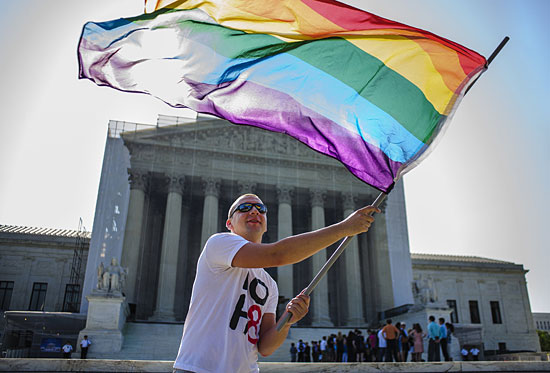
Gay rights advocates celebrated outside the U.S. Supreme Court, which effectively nullified California's Prop. 8.
They set the alarm for 5 a.m., two hours before the U.S. Supreme Court ruling, and turned on their TV.
For four years, Cesar Hernandez-Topete and his partner, Miguel Topete-Hernandez, had been waiting. They’d rented an apartment together, launched a business together, applied to become foster parents together, even cared for their bulldog-terrier mix, Grace Kelly, together. Under the law, however, they couldn’t do the one thing they wanted most—to marry and spend the rest of their lives together.
So when the courts cleared the way on Wednesday morning for the resumption of same sex marriage in California, the Long Beach couple embraced in the morning light and celebrated the news together.
“It was really emotional,” says Cesar, 26, adding that he and Miguel had been hoping for an autumn or winter wedding. “We hugged and cried, and Grace Kelly was jumping around—probably because now she won’t have two fathers out of wedlock! I believe so much in our relationship and everything we’re doing together. I knew that one day, we’d be gratified.”
As Californians absorbed the significance of Wednesday’s rulings, local officials prepared for the rush back to the altar amid the demise of Proposition 8. In Los Angeles County, Registrar-Recorder/County Clerk Dean Logan said that much of the bureaucratic framework is already there, but that the county will be adding locations where couples can schedule civil ceremonies.
“This is a customer service issue for us,” says Logan, noting that a bevy of temporary chapels are being set up at the office’s Norwalk headquarters and in municipal buildings in West Hollywood and Long Beach. “We already have the infrastructure in place.”
Wednesday’s decisions, viewed as back-to-back victories for gay and lesbian couples, struck down the federal Defense of Marriage Act and dismissed an effort to stop marriage equality in this state. One ruling guaranteed federal benefits to any couple, of any sexual orientation, whose state declared them to be legally married. The other found that the private citizens who sponsored California’s ban on same sex marriage lacked legal standing to appeal after a federal judge in San Francisco struck it down.
The latter ruling effectively nullifies Prop. 8, which voters passed in November, 2008, after a court decision earlier that year had allowed more than 18,000 gay and lesbian couples to marry in California.
Bureaucratically speaking, Logan says, those 18,000 marriages were a godsend because they forced a number of adjustments that will make the transition much easier as same-sex marriages resume. In Los Angeles County, for instance, marriage license forms were changed in 2008 to ask for the names of “Party A” and “Party B” instead of the “bride” and “groom.” And the plan to partition a conference room in Norwalk into spillover chapels was devised in 2010, after an initial court challenge to Prop. 8.
Though a federal judge held Prop. 8 to be unconstitutional that year, the 9th U.S. Circuit Court put same sex marriages here on hold pending the U.S. Supreme Court appeal. Because of that hold, Logan notes, marriage licenses still can’t be issued immediately to same sex couples. The Ninth Circuit Court has to officially lift its stay and state officials have to process the necessary orders—a process that is expected to take up to a month.
When that happens, however, “we’ll be ready,” Logan says.
At the Norwalk office, where civil ceremonies are offered daily, the extra chapel space will allow more couples to schedule ceremonies at the time they pick up their marriage licenses. Meanwhile, branch offices—which currently perform civil ceremonies only on Fridays—will temporarily add a second day for scheduled services.
Additionally, he says, the county will be partnering with the cities of West Hollywood and Long Beach to set up temporary satellite offices where civil ceremonies can be scheduled. Couples, he notes, will still have to go to a county office or go online to get their marriage licenses, but the partnerships will create additional locations in cities with large gay and lesbian communities.
“We’re getting a lot of inquiries here,” says West Hollywood City Clerk Corey Schaffer. “People seem excited beyond belief.”
Schaffer says that in the brief window before Proposition 8, the city and county also partnered to accommodate the demand for marriage. “We did over 600 ceremonies in those four months,” he says.
Now that the ban is being lifted, he says, the city will again schedule ceremonies at Kings Road Park, “a beautiful little park where we put an archway up in 2008, where people could stand and solemnize their marriages. We anticipate a very busy crowd.”
At the Registrar-Recorder/County Clerk’s Office, deputized volunteers perform most of the ceremonies. Logan says the office has heard from a number of community members and elected officials who want to pitch in this summer—which, even without same sex marriage, is the peak wedding season. (Click here if you, too, would like to volunteer to officiate).
In June 2008, on the first week of the window during which same sex marriage was legal in California, Logan says, the county’s average daily tally of marriage licenses leaped from 194 to more than 500 per day. This time, though, he doesn’t expect a surge, preparations notwithstanding.
“Unlike 2008,” he notes, “couples don’t need to be concerned that this isn’t a permanent decision. It’s the law now. It’s not going away.”
In Long Beach, Cesar and Miguel say they may take advantage of the county’s expanded service. “I think we’ll want a private ceremony,” Cesar says, “just something quiet. “
What’s most important, he says, is that the law is on their side now. “We want our children to be able to say we’re their fathers. I want to be able to say I have a husband, not just a boyfriend.”
He and Miguel, he says, have been together since a friend tagged them on a Facebook photo. On Wednesday, his Facebook page completed their story. “Today,” he posted, “Marks the Beginning of the Rest of our lives.”
Posted 6/26/13
When nine lives aren’t enough
June 20, 2013
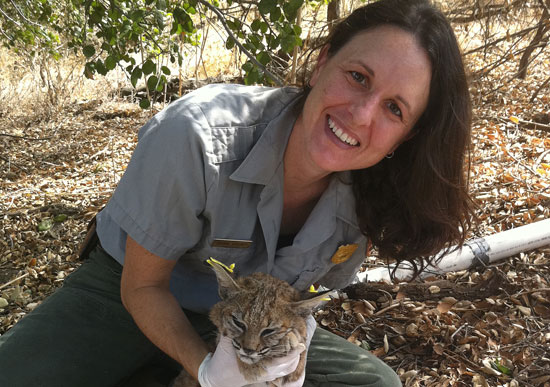
Wildlife biologist Joanne Moriarty says fire adds yet another dimension to the stresses on the region's bobcats.
The sighting was unusual and upsetting. Just days after fire-ravaged Sycamore Canyon re-opened, worried hikers began to report seeing a bobcat sitting passively on a charred trail. Alarmingly skinny, she was not running away. Her whiskers were singed, and it was clear she’d had an earlier encounter with people. Her ears, they said, were tagged.
National Park Service officials, who’ve been tracking and studying bobcats in the Santa Monica Mountains for years, searched the canyon but couldn’t find the spotted cat. Then, earlier this month, a report came that left no uncertainty about the animal’s condition or location. A hiker found her dead a few miles beyond the Point Mugu State Park campgrounds, north of the Los Angeles County line.
Wildlife ecologist Joanne Moriarty of the park service says the bobcat’s entire “home range,” or habitat area, had been incinerated. “But the biggest thing was that her paws appeared to be burned. She couldn’t hunt or walk very well.”

This bobcat, its paws burned, would later be found dead by hikers as a result of the Springs fire in May.
The bobcat’s death, announced last Thursday on the Facebook page of the park service’s Santa Monica Mountains National Recreation Area, prompted an outpouring of comments lamenting the animal’s fate. One mountain biker, who’d seen the bobcat on the trail, said “it was the saddest thing to have to walk away from [her]. RIP beautiful cat.”
But the death also came with an irony for park service researchers—and a lesson for the broader public living in the region’s tinder-box conditions.
Several years ago, the bobcat—known simply as B274—had been captured, tagged and monitored with 16 others as part of control group for a landmark study of bobcats in the area’s more urbanized areas, such as Thousand Oaks and Westlake Village. There, the animals had been hit with an epidemic of potentially deadly mange. Researchers theorized that the cats’ immune systems had been compromised by eating rats poisoned with anti-coagulants, the most commonly used method of rodent control. Meanwhile, the control group, outfitted with GPS collars and living in the wilds, showed no evidence of mange or other immune problems.
But, in the end, bobcat B274—and probably many others—couldn’t be saved from another modern-day reality: An estimated 94 percent of wildfires in the Los Angeles region’s mountains are ignited not by nature but people acting carelessly, negligently or maliciously. “Even though these bobcats were in a much more natural area,” Moriarty says, “in reality they were still highly affected by human causes.”
According to investigators, the rampaging Springs fire, which came at an extraordinarily early time in the year, was accidentally caused by an “undetermined roadside ignition of grass and debris,” most likely from a passing vehicle.
Moriarty says that bobcats, which are solitary and territorial, are already stressed because their habitat has been sliced by roads and shrunken by developments. Now, with officials this week warning of fire conditions that look to be the worst in a century, she and other scientists worry that the toll on wildlife could be profound, especially with fires flaring earlier in the year because of worsening drought conditions.
Moriarty feels certain, for example, that bobcat kittens were killed in the Springs fire because it came during the “denning” season, when mothers are caring for litters of up to five kittens in the mountain underbrush. Of the 5-year-old bobcat found on the trail, Moriarty says, it’s “very possible she may have had kittens.”
And this, of course, raises broader concerns about survivability. “Anything that affects reproductive timing has huge impacts on a population’s ability to exist,” says biologist Laurel Serieys, who’s been collaborating with the National Park Service on bobcat research and runs a website called Urban Carnivores. “Human impacts on the environment and the wildlife extend far beyond the city boundaries.”
Exactly how many bobcats survived the wind-driven flames that hop-scotched through Sycamore Canyon is unknown. “Definitely, some of them are going to end up perishing,” Moriarty says. Budget permitting, she says, she’d like to set up remote cameras to track possible survivors and document the challenges they’ll surely face.
“As a person, it makes me sad,” Moriarty says of the likely bobcat deaths. “But as a scientist I find it interesting. We’ll have an opportunity to learn how even those who managed to escape are still going to be negatively impacted by the fire.”

National Park Service officials have undertaken the largest study ever of bobcats, monitoring them in the Santa Monica Mountains with GPS collars. Photo/Pete Padilla
Posted 6/20/2013
Finding foot room at CicLAvia
June 6, 2013
Deborah Murphy’s first experience with CicLAvia was no smooth ride. She was walking her Jack Russell terrier down the sidewalk in East Hollywood when she decided to make a move to the car-free streets.
“Get out of the road with your dog, lady—this is for cyclists, stay off the street,” she remembers someone yelling.
When the next CicLAvia brought more shout-downs, the long-time pedestrian advocate and founder of Los Angeles Walks decided to form WalkLAvia, a group aimed at staking pedestrians’ claim to a share of the roads during the events.
“This is an open streets event and people should be out there walking or on bikes or doing cartwheels or whatever they want to do,” Murphy said.
No one would love to see that more than CicLAvia’s organizers, who’ve been pushing for that kind of inclusivity from the beginning. To make that point abundantly clear, they’re billing the upcoming
June 23 event along Wilshire Boulevard’s “Miracle Mile” as “the most walkable CicLAvia ever!”
“This all feeds into the ultimate purpose of CicLAvia—to connect people with their community in a way that is not possible in a car,” said CicLAvia spokesman Robert Gard. “On bike and, more specifically, on foot, you are really able to interact with your fellow Angelenos.”
But turning that long-held aspiration into a reality has proven increasingly elusive as the event’s popularity has grown. The last event, which opened a 15-mile stretch of streets from downtown to Venice Beach, drew a crowd of about 180,000 people, according to Gard. The overwhelming majority of them were on bikes. “There are so many bicyclists now, walking appears to not be part of it,” Gard said.
Unlike the last route, however, the new one along Wilshire Boulevard will be just 6 miles, with pedestrian-only zones at each end. Although architecture tours and other walker-friendly activities are planned, organizers think the location itself may lure more walkers. The Wilshire route will offer more street life and more sights—from MacArthur Park to Koreatown to “Miracle Mile,” with its museums and vibrant arts scene.
Of course, any event with “cycle” in its name is bound to attract a bike-heavy crowd. But part of the challenge is simple growing pains, Gard said. CicLAvia was inspired by ciclovías in Bogotá, Colombia, which began in the mid-1970s. L.A.’s first event was held just three years ago, and local cyclists jumped at the chance to freely ride streets, where automobile traffic normally makes biking nerve-wracking, even perilous.
Once people realize CicLAvia events are here to stay, bike riders won’t jump at the chance to ride every one of them for fear they’re missing a once-in-a-lifetime opportunity. “In talking with our peers in Central and South America, once they were more established, people understood it better,” Gard said. In time, serious bicyclists came to accept that ciclovías were for riders of all ability levels—and for pedestrians, too.
Alissa Walker, a member of Los Angeles Walks’ steering committee, said attitudes have already started to change.
“It has gotten a lot better,” Walker said. “At first, people didn’t understand that it wasn’t a race or something. It was possibly dangerous.”
CicLAvia organizers, in hoping to encourage that evolution, highlighted the problem using a video of a disabled man describing how he was verbally abused and directed off the streets because he was on a special, motorized device to accommodate his disability.
The City of Los Angeles’ first-ever pedestrian coordinator, Margot Ocañas, has participated in all six CicLAvias—sometimes on foot, sometimes on bike. She believes that continued, heavy interest from cyclists will mean that the roads “below the curb” will probably remain dominated by bikes, while pedestrians will take the sidewalks. For safety’s sake, she said, that’s not necessarily a bad thing.
Creating more pedestrian-only areas could help bring out more walkers, Ocañas said. She also envisions using the main route as a “launch pad for walking activities that tentacle off into other areas.”
No matter how CicLAvia evolves, everyone agrees that it should keep on rolling, stepping and hula-hooping.
“The fact that the bikes and pedestrians are having that conversation,” Ocañas said, “I’ll take it any day over bikers or pedestrians having that conversation with a car.”
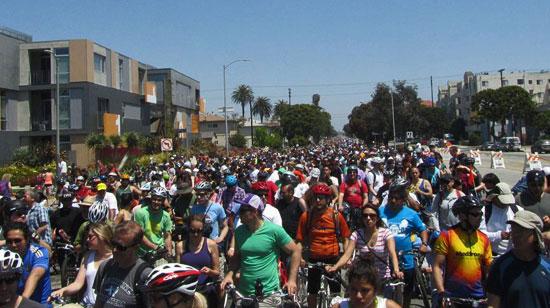
There were so many cyclists at April's event that they became walkers, like on this stretch of Venice Boulevard.
Posted 6/6/13
Lowering the heat on bonfire dispute
June 5, 2013
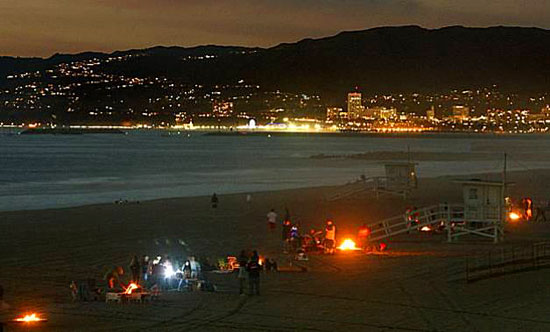
A shift in direction by air quality officials could keep fires burning on Dockweiler State Beach. Photo/L.A. Times
A hotly contested proposal to ban wood burning in Southern California’s iconic beach fire rings appears to be going up in smoke.
An official with the South Coast Air Quality Management District said in an interview on Wednesday that “an alternative proposal” had been developed that would continue to allow bonfires on the region’s beaches so long as certain measures were undertaken by June, 2014, to minimize the known harmful effects of burning wood.
“From our standpoint, we have better and more information than we had two months ago,” said AQMD project manager Tracy Goss. “A one-size-fits-all doesn’t necessarily apply in this case.”
And that’s good news for the popular pits at Dockweiler State Beach, which, under the earlier proposal, would have fallen victim to a dispute flaring 50 miles south, where Newport Beach officials are determined to remove 60 fire rings. Some residents there have complained of respiratory problems and smoke-drenched homes. At Dockweiler, the neighbors include LAX, a sewage treatment plant and an oil refinery, and they’re not complaining.
Restricting fires at Dockweiler for health reasons “doesn’t make a whole lot of sense,” Goss acknowledged, noting that the latest proposal would take a more nuanced beach-by-beach approach based on such things as topography, wind and proximity to homes. Goss declined to provide specifics until the plan’s public release, scheduled for Thursday. Already, the agency has two “public consultation meetings” set for next week on the new proposed amendments to Rule 444, which regulates “open burning.”
Of the national attention the AQMD’s earlier proposal attracted, Goss, a 25-year veteran of the agency, said: “When they make a political cartoon of your issue, that doesn’t happen very often.”
Kerry Silverstrom, chief deputy director of L.A. County’s Department of Beaches and Harbors, welcomed the news that Dockweiler’s fire pits will likely be spared. “We’re delighted,” she said. But she questioned why they were ever at risk. “On the scale of what’s bad for us,” she said, “fire rings at Dockweiler wouldn’t be the first thing I’d be talking about.”
She said the concrete rings have been there since at least the mid-1970s, when the county began running the beach at the foot of Imperial Highway. As much as 43 percent of Dockweiler’s annual parking revenues, or $570,000, comes from fees after 4 p.m., Silverstrom said—clear evidence of the popularity of the rings. “They provide a low cost recreational opportunity for a diverse population,” she said. “We see it as an access issue.”
So did the staff of the California Coastal Commission when, in February, it recommended denying Newport Beach a permit to remove fire pits that the mayor and city council contended were jeopardizing residents’ health. (Critics accused homeowners of simply trying to discourage undesirable outsiders from flocking to their affluent neighborhood.)
The commission staff stated that the removal of the rings would “deny the public access to this popular form of lower cost public recreation.” It also said the city had failed to demonstrate that the rings were “directly responsible” for health problems.
It was around this time that the AQMD entered the fray at the urging of board chairman William Burke, who also sat on the Coastal Commission—a job from which he’d resign as questions arose in Sacramento over a potential conflict between his positions on two agencies at odds with each other.
More specifically, Burke’s departure came after he said during an AQMD meeting in February that a nighttime aerial picture of the Newport fire rings reminded him of “carpet bombing” in Viet Nam, where he’d served in the armed forces. “This is Viet Nam revisited,” Burke said, but then quickly added: “Now it’s not really that bad because Viet Nam was horrible.”
As the AQMD continued to push for a regional ban, other cities pushed back, most notably Huntington Beach, which said its fire rings were a source of pride and commerce; they help “surf city” reap $1 million annually in parking revenues.
On Tuesday, the city’s community relations officer, Laurie Frymire, appeared before members of the Los Angeles County Board of Supervisors. “Our fire rings have been enjoyed for more than 60 years by folks from all over,” Frymire said, as she thanked supervisors for passing a motion by Don Knabe, whose 4th District includes Dockweiler Beach. The motion called on the board to oppose any action by the AQMD to ban fire rings region-wide and to leave such decisions to local jurisdictions. The Orange County Board of Supervisors, among other local government bodies, had earlier passed similar measures.
Now, given the shift in position by the AQMD staff, it looks increasingly likely that, at least in L.A. County, fire pits will no longer be a burning issue.
Posted 6/5/13




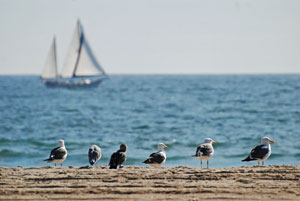
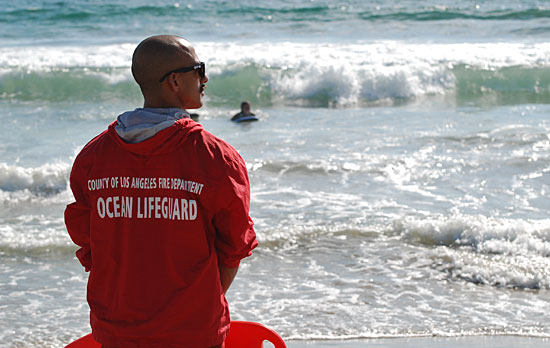
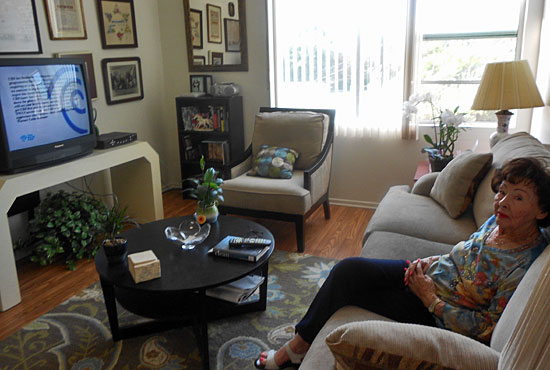
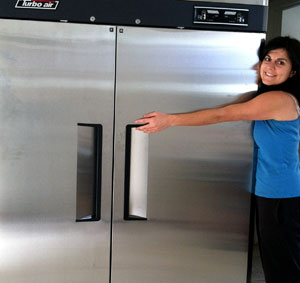



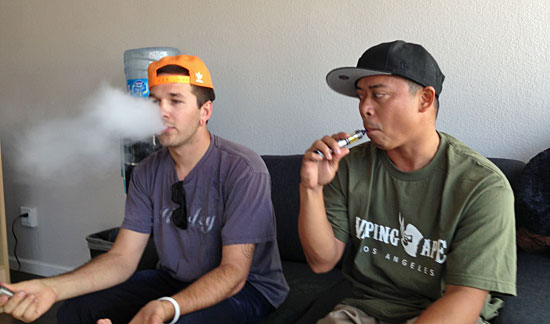
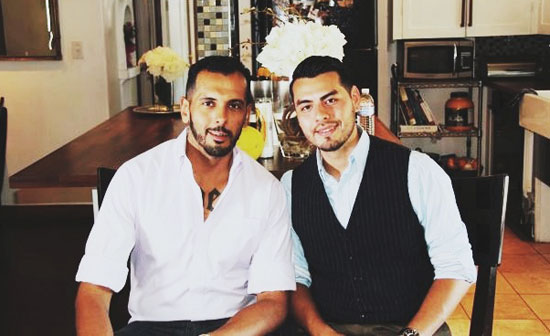
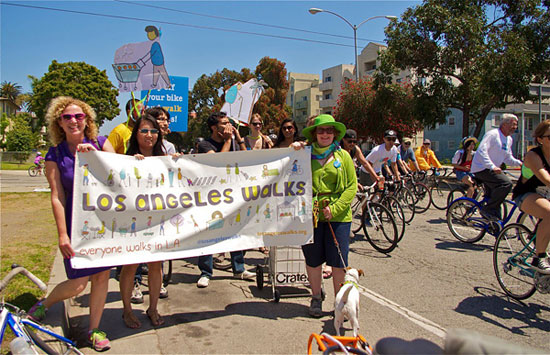





 Check for the latest closure information
Check for the latest closure information








